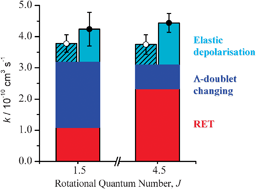Depolarisation of rotational orientation and alignment in OH (X2Π) + Xe collisions
Abstract
We have applied the

* Corresponding authors
a
School of Engineering and Physical Sciences, Heriot-Watt University, Edinburgh, UK
E-mail:
k.g.mckendrick@hw.ac.uk
Tel: +44 (0)131 451 3109
b Department of Chemistry and Biochemistry, University of Maryland, College Park, USA
We have applied the

 Please wait while we load your content...
Something went wrong. Try again?
Please wait while we load your content...
Something went wrong. Try again?
G. Paterson, S. Marinakis, J. Kłos, M. L. Costen and K. G. McKendrick, Phys. Chem. Chem. Phys., 2009, 11, 8804 DOI: 10.1039/B909050A
To request permission to reproduce material from this article, please go to the Copyright Clearance Center request page.
If you are an author contributing to an RSC publication, you do not need to request permission provided correct acknowledgement is given.
If you are the author of this article, you do not need to request permission to reproduce figures and diagrams provided correct acknowledgement is given. If you want to reproduce the whole article in a third-party publication (excluding your thesis/dissertation for which permission is not required) please go to the Copyright Clearance Center request page.
Read more about how to correctly acknowledge RSC content.
 Fetching data from CrossRef.
Fetching data from CrossRef.
This may take some time to load.
Loading related content
